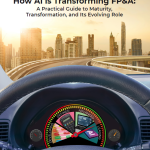In this article, explore how FP&A teams are using AI-powered forecasting models like Prophet and XGBoost...

I always admire and respect people who call out a number from memory to recite a tax or accounting rule. ASC 842 is for the leasing accounting guide, or Tax Code Section 24 for the Child Tax Credit. My brain is drawn to creativity and operational complexity. The FP&A function warrants more of this nature. FP&A is simply Financial Planning and Analysis. Both "Planning" and "Analysis" require creativity, forward-thinking, and looking to predict the future, with historical knowledge and business acumen. Analysis, by nature, is to use business knowledge and tell the business story via data.
There are different levels of maturity of FP&A professionals. I break them down into 3 levels. “Explain”, “Predict”, and “Prescribe”. Or simply put, to tell “What”, “Why”, and “How”.
Level 1: Explain ("What")
A freshman FP&A professional most often can tell the "What" and can "Explain" what the business results are. For example, "This month, our output is down by 10%," which caused the sales to drop by 10%. If the FP&A simply tells what the numbers are through obvious math, it doesn't provide much insight. Everyone can look at the numbers and figure the math out.
Level 2: Predict ("Why")
A semi-experienced FP&A professional, a level 2, is typically able to articulate the "Why", i.e., "Predict" or "Anticipate" what the reasons are behind the drop of 10% for output. He/she might be able to anticipate first, then dig deeper into the analysis to quantify through data. However, if the reality was that we just added some headcounts to the production line, the output should have been higher.
Then why are we not able to increase the output? Some business acumen or operational knowledge is going to be required now that He/she might be able to connect the dots and find out that new Headcounts require training. While they were not yet productive, their demand for training by the existing workers has negatively impacted the existing workers' productivity. The ability to dig out the "Why" and predict the outcome if the Why is not addressed is immensely critical. Without understanding the root causes, we cannot fundamentally cure the problem.
Level 3: Prescribe ("How")
After we find out the "Why", some finance professionals might think this is the end of the game. To be a more effective business partner, a seasoned FP&A professional, a level 3, should be able to challenge him/herself to address the "How" — How can we fix this problem? i.e., "Prescribe" the solution. Like a doctor, to prescribe the solution or the cure for the problem. What about "next time, we try phased hiring, i.e., hiring new workers in phases rather than all at once. Allow time for new workers to learn and existing workers to still have time to meet production needs". Or maybe the solution is creating a training video, so new workers can be trained by watching and following the training instructions, rather than taking time off from the existing workers, at least not as much time as it does today.
AI/ML: Threat or Opportunity?
As I described the three maturities of the FP&A profession, I didn't forget to address the "modern" part of the FP&A. "Modern" can have different meanings throughout the history of FP&A. Twenty years ago, we might have been thinking about using computers to forecast and simulate scenarios in today's environment.
One cannot miss Artificial Intelligence (AI) or Machine Learning (ML) buzzwords. AI/ML has not only become a buzzword but has also started to show an imminent threat to the FP&A world. Twenty years ago, we experienced the RPA (Robotic Process Automation) wave, where RPA could focus on automating repetitive tasks, such as matching an invoice to a PO automatically and identifying mismatches or errors. That has since become a standard tool used in today's business world. Many respective manual works have been replaced by systems/tools. We once thought that the analytical part, which requires layered analysis and judgment calls, would not be replaced by machines.
According to the 2025 FP&A Trends Survey:
- AI/ML users spend 39% of their time on high-value activities, 9% more than non-users.
- Among AI/ML users, 73% rate their forecasts as great or good, which is significantly higher than the percentage of non-users, 42%.
- FP&A teams using AI/ML report a 36% optimisation in performance compared to just 17% of non-users that report this.
However, AI is challenging the last human land we thought would never be occupied. And we thought that FP&A, the very creative piece of the finance world, would be salvaged. Not anymore. AI/ML algorithms have developed to the degree that they can handle automation more efficiently and more effectively than humans and learn, evolve, and understand patterns, adapt to new scenarios, and make decisions. Over time, it can learn from past data and understand the underlying structure and logic to forecast/predict the future. It warrants cognitive skills to a level that only humans have demonstrated on Earth. We didn't foresee the birth of the iPhone 30 years ago, and we didn't predict autonomous vehicles 20 years ago. Today, they are such a daily phenomenon that we soon cannot live without them.
Therefore, my conclusion is that we cannot predict what's going to happen 20 years from now. However, what we can do is to make sure we ride the wave of AI/ML. Do not fall off the boat sailing on the river of innovation. Let's keep learning and embrace the changes.
What FP&A Leaders Should Do Next
What should FP&A professionals do? Identify areas of daily work that AI/ML can improve. There are plenty of applications out there that are not that expensive to tap into. I am not going to name them. These applications can help generate reports/data in no time at the tip of your fingers. It will help you analyse the data the way you intend to and adjust the analysis as you demand it to. In the past, you needed an IT person to help you build a report in an ERP system, and it stayed the same format until the IT person helped you make a change. Now, you can ask the AI tool to pull the data however you want to see it and analyse it as if you have a personal FP&A analyst next to you. The speed and accuracy of the data will help the FP&A team bring more insights and solutions to the business leadership team. When the leadership team gets the insights more timely, they can take corrective actions faster.
Embracing AI: Enhancing Productivity and Strategic Foresight
Our IT team is currently developing an AI-powered assistant for our Accounts Receivable (AR) department. This tool leverages Machine Learning to analyse historical payment data, predicting which customers are likely to make late payments. As payment dates approach, it will use Natural Language Generation (NLG) to create customised reminder letters. Unlike generic templates, these letters will be tailored to each customer's unique payment history and purchasing behaviour, even incorporating targeted promotional offers. This initiative aims to automate tasks typically performed by multiple team members — from data analysis to daily customer reminders — freeing them for more strategic work. We're still fine-tuning the algorithms for self-learning based on past payment patterns and customer financial health.
This practical application resonates with broader industry trends. I recently discussed how a logistics company's CFO uses AI to predict fleet availability, integrating external data like weather forecasts to anticipate transportation gridlock. This allows them to proactively reroute shipments or deploy resources from other regions, a level of complex forecasting that previously required extensive human expertise.
I consistently encourage my team — across AR, AP, Accounting, and FP&A — to embrace AI, not fear it. While AI won't eliminate jobs overnight, staying abreast of these technological advancements is crucial for career longevity. Just as previous technological shifts required us to adapt and learn new skills beyond what computers could do, AI demands continuous learning and strategic leverage.
I extend this philosophy to my daughter, an aspiring architecture student. I have advised her to actively learn and utilise AI design tools. Generative AI can already produce stunning architectural designs. Her challenge, and ours, is to master these tools, becoming proficient "dragon trainers", *who harness AI's power to achieve unprecedented outcomes, rather than being replaced by it. By continuously learning and adapting, we can all ride the wave of this technological evolution.
Back to the FP&A function, imagine how much more value could be generated or losses prevented with the speed and accuracy on the FP&A side. RPA could replace the level 1 FP&A professional's work — Explain (What). AI could challenge the level 2 FP&A professional's work — Predict (Why). AI continues to challenge the level 3 — Prescribe (How). Based on my assessment today, I am confident that Humans still hold an edge in the level 3 work. But how long can I be convinced?
Footnote:
* The “How to Train Your Dragon” movie tells a story about how, when the dragon trainers learn about the scary dragons in a more profound way, they can become friends with the dragons and live in harmony.
Source:
Subscribe to
FP&A Trends Digest

We will regularly update you on the latest trends and developments in FP&A. Take the opportunity to have articles written by finance thought leaders delivered directly to your inbox; watch compelling webinars; connect with like-minded professionals; and become a part of our global community.







